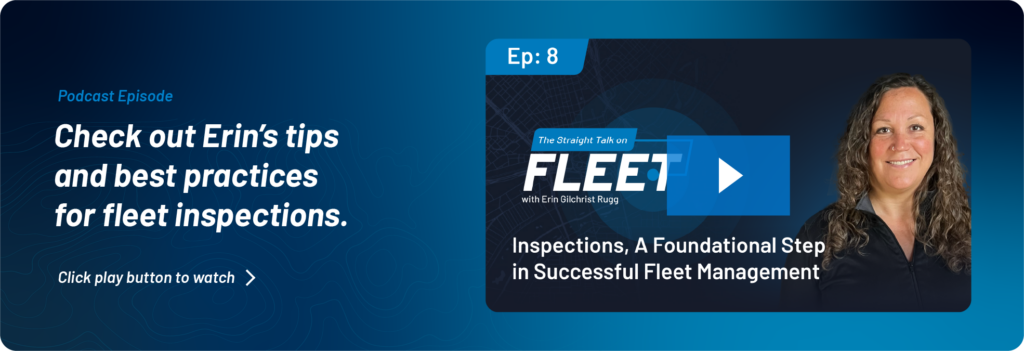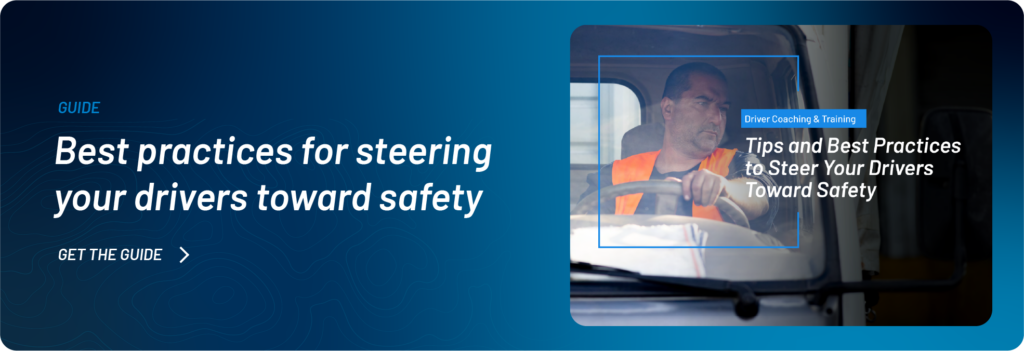Strategies to Improve Your CSA Score
Getting to – and maintaining – a good CSA score takes commitment and dedication. By prioritizing safety, driver training, and compliance, you can reap the benefits of a safer fleet, a stronger reputation, and a more efficient and profitable business. This blog post covers how to improve your CSA score through four different strategies, making sure that as points fall off your record, they don’t come back.
Strategy 1: Digital Inspections
Are your drivers getting citations and points for things that should have been caught before they got on the road? These are challenges easily alleviated through vehicle inspections.
Routine and thorough inspections are a cornerstone of fleet safety. It’s no surprise they will help your CSA score. But why are DVIR inspections even better? We can give you three quick reasons:
- Faster Inspections: Digital inspections take less time than paper-based ones, allowing drivers to spend more time on the road. This improves operational efficiency and reduces driver fatigue.
- Reduced Errors: Digital forms eliminate manual data entry errors, ensuring the accuracy of inspection records. This reduces the risk of receiving violations for inaccurate or incomplete data, directly impacting your score.
- Real-time Data Access: Inspection data is instantly accessible, allowing for immediate corrective actions and better tracking of trends. This proactive approach to addressing issues helps prevent future violations.
Digital inspection forms ensure consistency across inspectors and vehicles, preventing discrepancies and missed items. This standardization contributes to a more comprehensive safety culture, reflected in your CSA score. You will need to make sure your digital forms are set up to capture detailed information such as images, timestamps, and notes to be a strong resource during any audit. This information when brought back into a single connected platform such as IntelliShift, can also help identify trends and areas of improvement before they turn into any violations. The fact that everything is digital makes information easier to share with drivers, mechanics, and safety managers. Faster communication means faster corrective actions thus not only improving your CSA score but also enhances overall fleet safety, efficiency, and compliance.
Still wondering how digital vehicle inspections can improve your ELD score? Take it from a seasoned fleet leader. “I think the main reason we don’t push really hard and put inspections at the top of the list is because maybe we haven’t connected the dots on the cost of non-compliance. Ouch,” says Erin Gilchrist, host of Straight Talk on Fleet Podcast. “How do we create this environment of buy-in and compliance that makes the process smooth, seamless, and second nature?” Erin answers this question and more in Episode 8 of the Straight Talk on Fleet, “Inspections, a Foundational Step in Successful Fleet Management.”

Strategy 2: Electronic Logging Devices
Having problems with consistent electronic logging device (ELD) usage? Look, meeting the mandate is a no-brainer. But as a standalone action, it may seem like just one more thing to do.
The truth is, there is a huge amount of driver safety tied to tracking hours of service (HOS) and we know you know that. What you may not know is how treating ELD as part of the bigger fleet management picture can make it more integrated into your drivers’ workday and provide you with more helpful insights. More compliance, more actionable insights, it’s a win-win. If you are wondering “how can ELD improve my CSA score?” we can show you how to make it happen:
- Integrate your point solution – create full driver data visibility, which means you can track and record mandated HOS and the completed inspection checklists. Everything lines up in a single view.
- Pair DVIR and ELD reporting – by having DVIR and ELD for your drivers in a single mobile app, drivers consolidate the number of steps they are taking and amount of paperwork they are shuffling.
- Set up real-time alerts – configure your setup to send real-time alerts to team members that initiate maintenance and scheduling. You’ll keep vehicles at risk of violation off the road while your business continues running smoothly.
Initial setup of this process and technology will take some effort, but it is a great way to engage drivers in their own safety and protecting the business. A successful implementation and rollout will result in positive outcomes such as eliminating your HOS violations, which directly affects your CSA score, fines, and out-of-service orders. In the case of an accident, you’ll also have access to the best possible data to defend against unwarranted claims.
Approximately 51% of adults have driven while drowsy, with an estimated 17% falling asleep at the wheel in the past year. (Source)
But let’s talk about less obvious outcomes. By prioritizing fatigue-free driving, you’re laying a strong foundation for a culture deeply rooted in safety. This proactive stance not only promotes well-being but also enriches your driver training programs with invaluable insights, ensuring your team reaches its highest safety potential. On the administrative front, imagine a world where record-keeping no longer means sifting through daunting mountains of paper. The transition to streamlined, digital records doesn’t just declutter your workspace; it liberates your time, allowing you to focus on what truly matters.
Strategy 3: Driver Scorecards
Are you wondering what to do with the amazing data you are now collecting? Use it to populate driver scorecards. Once configured, scorecards can bring an organization together on safety, and you’ll progress much faster as a team.
The first thing you want to do is think about how you should weigh safety categories to match your business needs. You’ll also want to enable a mobile version of the scorecard so you can keep drivers involved and engaged. Finally, set up a dashboard to have real-time snapshots of safety events by type or status, as well as trends over time.
How can driver scorecards improve your CSA score? By addressing risky behavior, promoting safe driving, and encouraging continuous improvement, driver scorecards contribute positively to several key areas of your CSA score:
- Unsafe Driving: Reduced violations for speeding, harsh braking, and other risky behaviors.
- Crash Indicator: Lower accident rates resulting from safer driving practices.
- Driver Fitness: Improved overall driver competency and awareness of safety protocols.
Use your safety scorecards to identify risky behavior; key metrics like speeding, harsh braking, idling, and seatbelt usage will aid in targeted intervention before accidents or violations occur. But avoid making it a hunt for errors. It’s building a safety culture overall, which includes promoting safe driving habits and data-driven coaching. Incentivize your safety and implement rewards systems. Some fleets find success and engagement with their teams by gamifying their safety programs.

Strategy 4: Driver Training
If you are busy juggling a million things and don’t have time to stop and design training programs, you’re not alone. Fleet leaders are often wearing many hats and simultaneously responding to real-time situations. All that is to say, it’s not responsible to halt your driver training process at the onboarding stage. It needs to be an ongoing activity for your team in order to achieve a culture of safety and improve your CSA scores. Yes, including when your drivers’ performance is outstanding.
In an estimated 25-30% of crashes, distracted driving is a factor. This represents a minimum of 4,000 collisions every day. (Source: OSHA)
If you have been struggling in this area, it could be that you need to use your fleet safety technology in a different way. We have covered meeting the ELD mandate, integrating with inspections, using a dashboard, and now it’s all about application to programming.
- Look for trends across the scoreboards. Where are drivers repeatedly struggling? Now you have a high-risk topic to cover with them straight away.
- Take a closer look at inspection trends. What issues come up often? Is there something that additional training can alleviate? Now you have a preventative topic.
- Think about the uncontrollable situations your drivers face every day. They have a split second to react in that moment. But have they had the opportunity to practice responding? If you provide a safe place to discuss and practice defensive driving techniques, hazard recognition, and accident avoidance strategies, you will now have a proactive topic.
- Set a routine safety meeting time and stick with it. But if something high-risk comes up, of course it should be addressed immediately. Make training a priority in your safety program.
While the above is all about the engagement with drivers to continue improving, the last piece mentioned here is the most important, and that is a fundamental safety policy. The only thing worse than violating your safety policy is not having one at all! All of these things combined will support achieving and maintaining CSA compliance, and maybe even a lower insurance premium. You’ll have better driver retention and an improved company reputation. A robust training and fleet safety program is something to strive for and be proud of.




![Episode 50 Thumbnail Erin celebrates building the fleet community with 50 episodes and 11K followers on LinkedIn [Podcast]](https://intellishift.com/wp-content/uploads/2024/02/MOFU-Imrpove-CSA-Header-1.jpg)



